Figure 1.1
Orion the Hunter dominates the winter sky. The constellation is a veritable treasure-trove of sights for stargazers.
(All images are oriented so north is up, unless otherwise indicated.)
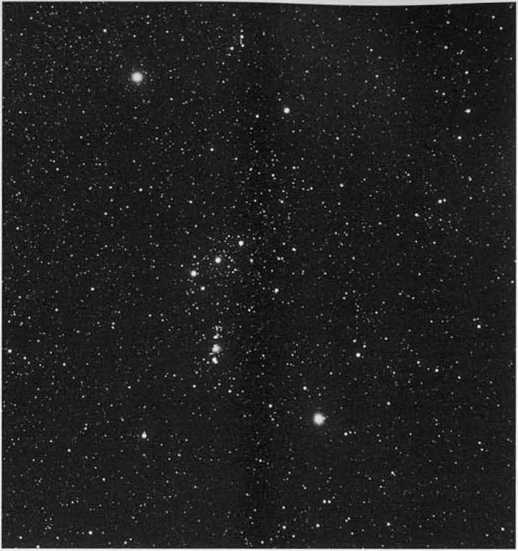
CHAPTER 1
Walter Scott Houston poured his heart and soul into his writing. Reading his words, you often felt as if someone you love had wrapped an arm around your shoulder on a cold winter night and, pointing a finger toward the heavens, spoke with passion and eloquence about the night sky. It was as if he were teaching his daughter, or son, or best friend about the sky. In this column, adapted from Deep-Sky Wonders for January 1991 and written just three years before his death, Scotty recalls a time when, as a boy with his telescope under the moonless sky of Wisconsin, he felt "lucky to walk in the January night under the glory of Orion."
I learned my constellations in Tippecanoe, Wisconsin, a town that long ago vanished into the urban sprawl of Milwaukee. Back then Tippecanoe was a rather treeless tract of farmland bounded by the great clay bluffs of western Lake Michigan. The sky ran right down to the horizon and, with an almost irresistible force, called for you to look at it. In January 1926, after a midnight walk home from ice-skating, I wrote:
Snow crystals sparkle like blue diamonds, but with a dreamy gentle radiance totally unlike the harsh gem. A rail fence as black as Pluto himself runs along the road. The forest is black in the distance. The landscape is a masterpiece in ultramarine and sable.
As if in contrast, the heavens above blaze with a thousand tints. Incomparable Orion leads the hosts with blue Rigel. ruby Betelgeuse, and bright Bellatrix. His silver belt and sword flash like burnished stellar steel. And more advanced is dark and somber Aldebaran, so heavy and gloomy. In fitting contrast are the delicate Pleiades, who sparkle ‘’like a swarm of fireflies tangled in a silver braid.”1
Figure 1.1
Orion the Hunter dominates the winter sky. The constellation is a veritable treasure-trove of sights for stargazers.
(All images are oriented so north is up, unless otherwise indicated.)


How can a person ever forget the scene, the glory of a thousand stars in a thousand hues, the radiant heavens and the peaceful Earth? There is nothing else like it. It may well be beauty in its purest form.
On a cosmic time scale, we are lucky to walk in the January night under the glory of Orion. The slow but constant wobble of Earth’s poles, which we call precession, made things very different in the distant past. In 10,000 B.C. Orion was a summer constellation barely visible from the Northern Hemisphere, as it will be again in A.D. 16,000. But for the present, no matter on which side of the equator we live, Orion rides high in the January evening sky.
I know of no constellation brighter than Orion (Figure 1.1). It contains two lst-magnitude stars and five of 2nd magnitude. I have long felt Orion is the first constellation amateurs learn, though mine was Scorpius because I began with the summer sky. I wonder if this gut feeling is borne out by actual numbers?
As night falls in January, Orion hoists his weight over the eastern horizon, bringing into view the "incomparable M42, the great Orion Nebula, about which words fail," as Scotty penned in 1955. "No amount of intensive gazing ever encompasses all its vivid splendor." To Scotty, the Orion Nebula was the most dramatic nebula visible from both hemispheres. Although the Eta Carinae Nebula is larger, it is visible to observers only from more southerly latitudes. But the Orion Nebula is more than in awe-inspiring sight: it is a historical wonder, an inspiration to astrophotographers, and an observer's paradise. It can fill the field of a telescope, regardless of size, with an array of visual splendors.
At this season, when most of the United States is covered by the cold and transparent blanket of the polar continental air mass, the nebula observer can do no better than to direct a telescope to the greatest of all spectacles — the Orion Nebula, middle "star” in the mighty Hunter’s Sword. Against the intense, sharp blackness of these skies, with the stars actually resembling their prototype diamonds, there is no other sight so well calculated to stir the observer’s feelings of awe and wonder. Even the naked eye perceives M42 as having a real diameter.
The Orion Nebula (Figure 1.2) has inspired more adjectives than any other deep-sky object. None, however, do real justice to this great mass of swirling, pale green, chaotic gas. Even “overpowering” is a most inadequate word when the nebula is seen in a really dark sky.
Intertwined with the Sword on the Hunter’s Belt, M42 requires no charts or setting circles. There’s no need for a finder either, since you can simply sight along the edge of the telescope tube to bring the nebula into view.
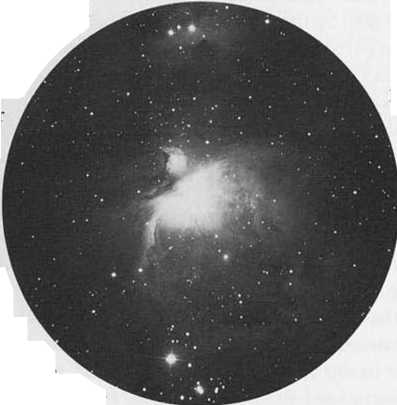
Figure 1.2
The great Orion Nebula (M42) is a cloud of
I gas and dust glowing from the light of hot young stars embedded in it.
who
Celestial Objects for the great Orion Nebula will fail to find it listed. This is not an incredible omission born of some careless printing, but rather a reflection of the
The reader looks to the index in William H. Smyth’s observing handbook Cycle of prevailing amateur interests of the early 19th century. This most impressive nebula in the entire heavens is listed by Smyth as a mere addition to the entry on the double star Theta (9) Orionis.
Most (but not all) of the great deep-sky objects have been handed down to us by a succession of famous past observers. The Orion Nebula, for example, was first discovered by the French naturalist Nicolas Peiresc in 1611, two years after Galileo began turning the newly invented telescope skyward. Reputedly missed by Galileo, the Orion Nebula was independently discovered by the Swiss Jesuit priest Johann Cysat in 1618 and observed by Christiaan Huygens in 1656. Legend has it as the first object viewed by Sir William Herschel in 1774 with his first successful telescope (after two hundred obvious failures at speculum making); a few years later, it was the final object to be looked at with the 40-foot reflector before its great glass was laid aside forever. It was the first nebula to be photographed (by Henry Draper), and its spectrum (observed by British astronomer William Huggins) sounded the death knell for the Herschelian theory that all nebulae were composed of stars and therefore ultimately resolvable.
Today, it is the first object the stargazer turns to on these crisp winter evenings. Every amateur maker of a Schmidt camera finds that the Orion Nebula is the only proven test of workmanship.The variable-star observer includes it while following the perplexing nebular variable, T Orionis, immersed in the misty light. Whether viewed with opera glasses or with a 16-inch reflector, no spectacle is better devised to open the year’s observing, no object brings more gasps from casual visitors, and no other nebula has such continuing power to stimulate the veteran lover of the stars.
Most published descriptions of M42 dwell on the aesthetic shock experienced by the observer rather than an actual description of the nebulosity. William Herschel was so taken by the view that nebulae became a lifelong interest. His son John later compared the nebula to a “surface strewn with flocks of wool — or like the breaking up of a mackerel sky when the clouds of which it consists begin to assume a cirrus appearance.”
The 19th-century French astronomical artist Leopold Trouvelot wrote that he saw M42 to advantage only once with the 15-inch refractor at Harvard Observatory in Cambridge, Massachusetts. That time he was able to see the cirrus pattern mentioned by Herschel. This detail is a real observing challenge.
Garrett P. Serviss, the author who taught my generation and the one before it to appreciate the heavens, referred to stars in the Orion Nebula as “shining like gems just dropped from the hand of the polisher."2
Drawings of the Orion Nebula made before the influence of photography raise more questions than they answer. Only superficially do the sketches bear any resemblance to one another. The bright section of the nebula drawn by Bindon Stoney using Lord Rosse’s 3-foot reflector in Ireland doesn’t begin to match what I saw in 1935 with the 36-inch reflector at Steward Observatory in Arizona. Trouvelot’s 1882 lithograph based on observations with the Harvard 15-inch is a reasonable match to my view through a 3-inch. On the other hand, John Matias’s drawing in the Messier Album, made in the 1960s with a 4-inch telescope, shows features that most observers need a 10-inch to see.
As for details in the brightest portion of the nebula, try using very high magnifications. This may bring out the cirrus effect that Herschel and Trouvelot mentioned.
The nebula stands up well under all sizes of telescope and all powers. With high magnifications, the intricate curdlings of its luminous masses rival and resemble frost paintings. Its chaotic form gives a strong impression of twisting -ind turbulent motions that are too slow to follow. It is so bright that its green tint is obvious to most. Some have even glimpsed reds and pinks in the curdling clouds. With low powers and a field wide enough to include the whole nebula, it becomes an object compelling enough to draw exclamations of delight from even the most disinterested bystander. Observers should use averted vision until they can trace the luminous beauty of the Orion Nebula far beyond the bounds normally assigned to this entrancing object. The telescopic view of M42 overspilling the widest eyepiece field more than compensates for cold feet and numbed fingers.
"Orion contains three deep-sky wonders that are unmatched elsewhere in the sky," Scotty once exclaimed. The brightest and best of these is obvious: the great Orion Nebula. But the other two objects — Barnard's Loop and the Horsehead Nebula — are hardly sights for untrained eyes. Some experienced observers have spent decades trying to view them with a variety of telescopes, but without luck. Obviously, the photographic appearance of these objects is what impressed Scotty. Still, he believed that what could be recorded on film might also be within the realm of possibility for the observer, and his columns quickly became the place to turn to for new challenges. Indeed, it was Scotty's curiosity about the chances of seeing such "impossible" wonders that spurred generations of amateurs to put their skills to the test and rewrite the annals of visual astronomy.
ne observing frustration in my younger days was that I could not see
Barnard’s Loop — a huge, dim arc of glowing gas believed to be a remnant of an ancient unrecorded supernova. It is superficially similar to, but larger than, the Veil Nebula in Cygnus. The eastern half is quite well defined, while the western portion, if it actually exists, is seen only as a few nebulous patches. If it were a complete circle, it would be about 10° in diameter and roughly centered on Orion’s Sword.
Although the name implies that astronomer Edward Emerson Barnard discovered this nebulosity, he did not. After finding it on his photographs made in October 1894, Barnard remembered that the Harvard astronomer William H. Pickering had written about the arc more than four years earlier. Pickering had discovered it on photographs made at Mount Wilson (then called Wilson’s Peak) >n 1889. Why the loop became associated with Barnard is a bit of a mystery, especially since Barnard's original description of the nebula quoted Pickering's work extensively.
For years Barnard’s Loop (Figure 1.3) was a goal only for astrophotographers. No one I knew had ever seen it visually. I had searched with my homemade 10-
Figure. 1.3
Barnard's Loop is a three-million-year-old emission nebula. The eastern portion is shown here at left. While it shows up often in photographs, the Loop presents a visual challenge for observers.
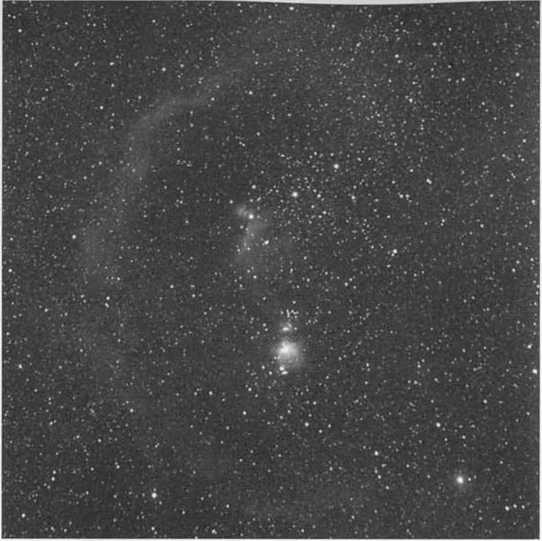
inch f/8.6 reflector as well as 6- and 15-inch Clark refractors3 to no avail. The object defied all my bizarre optical creations until I saw it with, of all things, the naked eye. That, however, was because Lumicon began manufacturing O III nebula filters. I was absent-mindedly comparing naked-eye views of the sky with and without the filter under the mediocre observing conditions here in Connecticut when I chanced upon the loop. My wife says I jumped clear over the observatory (it’s a small building). Since then, I have duplicated the feat at dark sites in Texas, Southern California, and Mexico, my only accessories being a Lumicon ultrahigh-contrast (UHC) filter and a dark cloth over my head.
Nevada observer Richard Johnson and California amateur John Bartels have been doing the same thing. By contrast, attempts to catch sight of even its edges with a 4-inch 20x rich-field telescope, under good conditions but without the filter, have so far met with despair. Many astrophotographers consider it quite a feat to capture the loop on film; seeing it visually is even more remarkable.
The Horsehead
The Horsehead Nebula (Barnard 33) is one of the most photographed but least observed objects in the sky (Figure 1.4). It is incredibly challenging for visu-

observers, and until rather recently it was a prize worth crowing about even among photographers. The blob of darkness lies halfway along the streamer of f lint nebulosity that runs for 1° south from Zeta (£) Orionis, the easternmost belt star. The streamer 1C 434 (the abbreviation IC stands for Index Catalogue, a supplement to the New General Catalogue of Nebulae and Clusters of Stars by j L E. Dreyer), is a bit brighter than the Veil Nebula in Cygnus, and no great feat to see. But recognizing the dark blotch B33 is another matter.
The Horsehead was first photographed about 1900, but was believed to be only a void in IC 434. Barnard appears to have been the first person to suggest that it was actually an obscuring cloud of material seen in silhouette. When I first suggested that amateurs look for the Horsehead in 1969, veteran deep-sky observers disagreed on its visibility in amateur telescopes. I then queried several active nebula hunters, and none reported seeing this object. Some thought that IC 434 was itself the target, while others mistook the rift in NGC 2024, northeast of Zeta, for the Horsehead.
The Horsehead is harder to see by far than the nebula around R Monocerotis (Hubble’s Variable Nebula). It is much harder than the Veil in Cygnus or spiral galaxy M33 in Triangulum. Possibly it is more difficult than the Mcrope Nebula in the Pleiades.In any case, the observer should wait for special weather and use a photograph as a detailed finding chart.
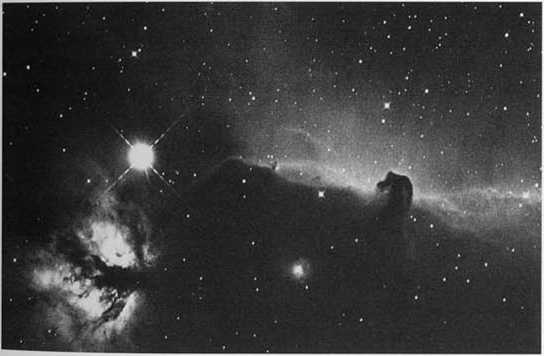
Figure 1.4
The Horsehead is the dark nebula B33 seen in silhouette against IC 434, which is much larger and very bright. NGC 2024 is at lower left. North is to the left.
Leslie Peltier, the well-known comet hunter of Delphos. Ohio, mentioned in a letter that he once saw it long ago. His telescope is a 6-inch refractor of about 1710, a type more common in Europe than this country, and he uses low-power oculars.
IC 434, but no Horsehead, was seen with a 2.4-inch refractor by Larry Krumenaker in New Jersey, with a 12-inch f/6.5 reflector by Ted Komorowski in North Carolina, and with 6-inch f/8 telescopes by Stephen Barnhart in Ohio and Mark Grunwald in Indiana. However, other observers were more successful.
California amateurs made quite a few sightings of B33, mostly from mountain locations. Harold Simmons of Broderick took three trips to the 2,500-foot site of Colfax Observatory before he found the elusive object in a 16-inch at 200x. Simmons attributed his success to an exceptionally clear, windless sky and superior optics.
On Onyx Peak, California, Leonard P. Farrar had difficulty in finding the Horsehead with a 10-inch and averted vision. But once it was located he could show B33 to several other people. His method was to identify five nearby faint stars on a photograph of the region and use these as a guide to the exact spot. "The nebula appeared to me as a slightly fuzzy jelly bean,” Mr. Farrar writes. “The color was a dark smoke gray.”
From De Funiak Springs, Florida, Wayne Wooten reports: “I have observed the Horsehead several times with my 10-inch at 50x, mostly on a cold night following a rainstorm.” He has been able to see it several times with his 6-inch richfield telescope.
From Connecticut my 4-inch refractor failed to reveal the Horsehead, but my notebook indicates that it was visible from Kansas with a 10-inch reflector. I have since fished it out using a 4-inch Clark refractor, a 4-inch off-axis Newtonian telescope made by Margaret Snow, and a 5-inch Moonwatch Apogee telescope under the same circumstances as Mr. Wooten, immediately after the passage of a cold front. Scattered light from 2nd-magnitude Zeta foils many attempts to find the Horsehead, since the two are separated by only V20.
Another reason that many searches fail is that observers are looking for the wrong-sized object. When I have seen it with telescopes between 10 and 16 inches in aperture, my first reaction has always been how tiny it is! Knowing just where to look for it is half the battle. The Horsehead is only about 5' across. Amateurs accustomed to seeing it on large-scale photographs made with professional telescopes end up looking for an object that is much too big. I was fortunate in my original quest since the only photograph I had to go by was from the Atlas of the Northern Milky Way, compiled in 1934 by Frank Ross and Mary Calvert. The three stars in Orion’s Belt spanned only 2 inches on these small-scale charts, and the image of the Horsehead looked pretty much the way it did in my 10-inch reflector. Having found it, however, I could easily translate the view to other telescopes.
John Bortle of Stormville, New York, sees it with his 12-inch f/5.5 reflector, using 40x and averted vision. In picking out faint objects near a bright star, it might help to use an ocular fitted with an iris diaphragm in the focal plane. This would be used wide open in setting on the field, and then, centered on (say) the Horsehead, it would be closed down to shut off all disturbing bright light.
Nebula filters are the main reason the Horsehead has fallen from the list of test objects. Anthony Nutley of Western Australia could see no trace of the Horsehead with his 10-inch reflector until he added an H-bcta filter that made it obvious. This filter, sold by Lumicon, is tuned to transmit nebular light from the hydrogen-beta (HP) emission line. Darian Rachal of Louisiana had a similar experience with an H-beta filter and his 17'/2-inch reflector.
Without a filter the Horsehead is still a challenge. If you want to take it on. then here's your competition: Peltier saw it with a 6-inch refractor. I've glimpsed it with the 4-inch Clark, and a group of four amateurs sighted it with Snow's 4-inch off-axis reflector.
Also, there is a question as to how easily it can be photographed. The well-known French observer Jean Texereau recorded the Horsehead with an f/5 lens of 1.6-inch aperture. Can you beat that?
In his July 1949 Deep-Sky Wonders column, Scotty wrote, "A number of readers have written of their inability to locate M33, the large spiral in Triangulum. This column will discuss the matter and the overall problem of the visibility of nebulous objects in a future issue." Then, in January 1955, he introduced one of his famous visual challenges: to spot M33 without a telescope. Scotty continually pushed his vision to the limit and challenged the limits of others. He never considered himself the "final word" on any observation. Scotty made observing a sport and enjoyed creating friendly competitions, through which he would ultimately discover the truth behind the power of the eye — not his eye, but "the" eye.
The great spiral in Triangulum (Figure 1.5), also known as M33 and NGC 598 (Figure 1.6). is a favorite of photographers and the despair of many visual
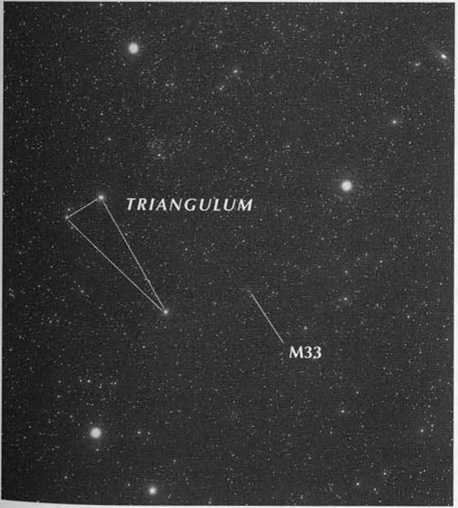
Figure 1.5
The constellation
Triangulum may appear small and unimportant, but it hosts the beautiful spiral galaxy M33.
observers. Although W. 11. Smyth, in his Cycle of Celestial Objects, called it "large and distinct" in his 6-inch refractor, this galaxy is much harder to find in a telescope than a beginner might expect. With a diameter of about 1°, the 7th-magni-tude spiral more than fills the field of view in high-power binoculars and presents an almost featureless glow that is easily missed. Therefore, very low powers or even small binoculars give the best view.
Amateurs have often searched telescopically without avail for this apparently elusive object, while others report it visible in finders or binoculars. Until recently no one had reported a naked-eye observation to me, although the rather discordant measurements of its integrated visual magnitude, 5.8 to 6.8, suggest that M33 might be seen in a really clear sky. There is a common misconception that
the faintest stars the human eye
Figure 1.6.
M33 lies about 2.4 million light-years from Earth and is part of the Local Group that contains the Andromeda and Milky
Way galaxies.
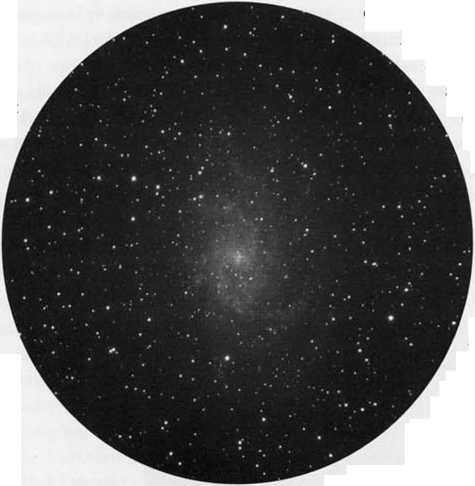
can see are 6th magnitude. But with a pure dark sky and good dark adaptation, the threshold of vision is actually considerably fainter. In fact, stars as faint as 8.5 have been detected by very keen-eyed persons when special precautions were taken.
Only one published reference to such naked-eye
visibility has been found. Knut Lundmark, discussing the limits of non-telescop-ic vision in the Hartdbuch der Astrophysik, Vol. VI, Part l,page 354, states,“The present writer is able to see with his unaided eye the object M33 having a total magnitude of 6.8.”
In September 1954, while observing meteors eight miles east of Manhattan. Kansas, I stumbled on the nebula accidentally. It was so obvious that at first I took it for a bit of cloud, but binoculars corrected the identification. To the unaided eye, stars well below magnitude 7.0 were easily visible that evening, and the nebula itself was a conspicuous luminous patch, very slightly brighter at the center, and apparently larger than its published major diameter of 60'. I made it easily 90', but somewhat less in binoculars.
Postcards were sent to other amateurs, whose attempts to verify the naked-eye visibility of M33 are reported here. Harold Peterson, after several failures in

<3C1 VJMVii’
Five other observers wrote me of unsuccessful attempts to see M33. One of these James Corn of Phoenix, Arizona, also remarked, “Dr. Carpenter showed me M33 through the 36-inch reflector at Steward Observatory, and I noticed a
condensation in one of the spiral arms. When I got home I tried my 12-inch and found the condensation easily: it is visible whenever the seeing is good.”
Since then the writer has seen M33 at House Springs, only 30 miles from St. Louis, Missouri, but I have never been able to see the galaxy from the city itself. Apparently M33 is visible to the naked eye, but only when skies arc quite clear and city smog is entirely absent. In August 1961 I told the Stellafane convention in Vermont that I doubted that anyone there could detect M33 without optical aid. But shortly after midnight the sky grew so transparent that this galaxy became visible, first by glimpses and later steadily, even without use of averted vision.
Telescopically, the texture of M33 is usually smooth, but one night I saw the whole surface surprisingly mottled, with the southeast part considerably brighter than the northeast. Dreyer’s New General Catalogue notes the galaxy as very gradually brighter toward the center, and Edwin Hubble suggests that the nucleus resembles a huge globular cluster. Some of the misty knots in the spiral arms are conspicuous enough to have been cataloged in the NGC as separate nebulae. Most observers settle for locating NGC 604, a bright knot in one arm 9.T east and 7.6' north of the galaxy’s nucleus.
One night in an 8-inch, a congested mass of bright patches was seen superimposed on an overall spiral pattern. Once before I had a similar view in a 36-inch. Mr. Bartek (a fellow observer) pointed out a patch some distance from the main whirl that made M33 resemble MSl.The patch was faint, but I held it steadily without averted vision.
In his December 1975 column, Scotty noted a seeming paradox concerning arge, loose star clusters that was originally reported by William and John

nonexistent" if it could not be recognized on prints of the Palomar Sky
Survey.’ But, as Scotty pointed out, the survey's large scale and deep limiting magnitude tend to conceal sparse open clusters. By the way, you still will not find these objects plotted on most star atlases, including the Millennium Star Atlas. Since Scotty's original column appeared, however, Brent Archinal (U.S. Naval Observatory) compiled the Non-Existent Star Clusters of the RNCC, published by the Webb Society in 1993, which includes the very objects Scotty introduced in his columns. We have plotted three of them on special charts for this book.
How well do descriptions in catalogs match what amateurs see in their telescopes? With his 6-inch f/7 Newtonian and its finder, Pat Brennan of Regina, Saskatchewan, has been looking at open star clusters, especially William Herschel’s Class VIII, the big scattered groups. All of these objects are listed in Dreyer’s classic New General Catalogue, together with descriptions based on visual observations. But often these characterizations do not match what Mr. Brennan sees with his instruments. One example he cites is NGC 1662 in northwestern Orion. The NGC description suggests a poor cluster, as does the fact that it is not plotted in either Norton’s Star Atlas and Reference Handbook or the Skalnate Pleso Atlas of the Heavens.4 5 But when he looked for this object, he was surprised to spot it easily in the 10 x 42 finder.
Mr. Brennan describes NGC 1662 as “a bright coarse splash of stars, the brightest being of 9th magnitude. Few of the 20 or so apparent members were fainter than magnitude 12. The cluster stands out well and is elongated approximately northwest to southeast, its maximum extent being about 12'. Near the center is a very small but distinct triangle of 12th-magnitude stars, the northernmost of which has a companion of equal brightness T to the west. While not a fine cluster, NGC 1662 can be seen easily in small apertures and is worth a look.”
This description fits quite well with what I see in my 4-inch refractor, but others may get a different impression.
Another loose object is NGC 2251 in Monoceros. It is plotted in the Skalnate Pleso Atlas, and its companion Atlas Catalogue indicates that it is 10' in diameter with 35 stars. A 12-inch telescope, however, reveals about twice that number, with a bright star in the center. In the 4-inch the group is smeared out like a long narrow arrowhead, but larger apertures round out the shape.
Also in the Skalnate Pleso Atlas is NGC 2169 in Orion, a cluster much less impressive than the omitted NGC 1662. Using a small telescope, look for a scatter of half a dozen stars. Larger apertures reveal as many as 30 within a 5' circle. Were it not already in the NGC, I would never have recognized it as a cluster.

Tliis object was originally discovered by William Herschel, who placed it in his class VIII.
An especially interesting task is to search for clusters that are designated "nonexistent" in the Revised New General Catalogue. Then, by direct observation, try to determine why they were included in the NGC. Mr. Brennan writes,"Have you ever encountered a ‘nonexistent' RNGC cluster alive and well, so to speak? I've found several, albeit the vast majority were coarse and less than impressive."
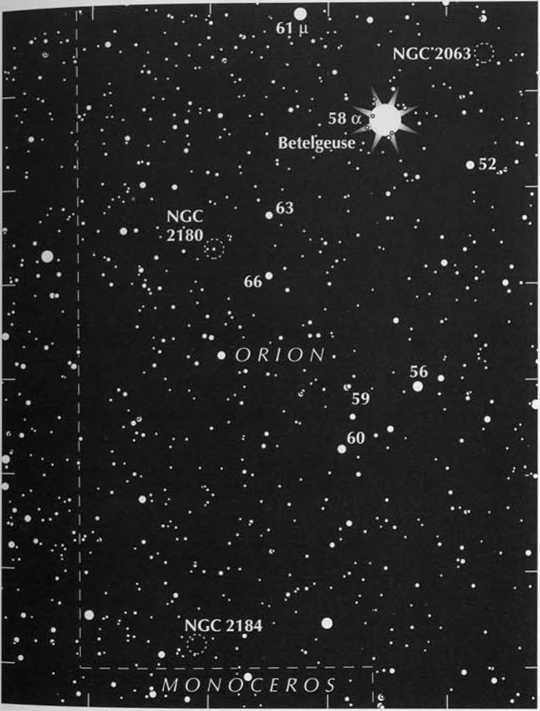
Figure 1.7
Finder chart for open clusters
NCC 2063,
NGC 2180, and NGC 2184.
6h2(tm 6h10*" 6h00m 5l,50m
NGC 2184 in Orion is such an object (Figure 1.7). Mr. Brennan saw it in his 6-inch and I did with my 4-inch. The NGC description is “cluster, large, very little compressed.” Mr. Brennan’s account is more detailed. “At 67x a very pretty sight. It contains 30 to 40 stars, the brightest of 9th magnitude with others down to 12th. They appear evenly arranged in a roundish grouping 12' to 15' in diameter. Lovely view at 38x. I would certainly rank NGC 2184 as one of the top clusters in Orion and better than most of the 25 I have observed in Monoceros.”
This apparent discrepancy results from the procedure used by Jack W. Sulenlic to check the reality of each object. For this he used prints of the Palomar Sky Survey, which shows galaxies and nebulae beautifully. But the large scale and deep limiting magnitude tend to conceal sparse open clusters.
1 also checked a Palomar print and found a vague indication of the cluster, but it was so spread out that some imagination was needed to discern it. However, on the much smaller scale of the Atlas of the Northern Milky Way, NGC 2184 is clearly visible, and on a still smaller-scale picture by E. E. Barnard it is even more distinct.
NGC 2180 is also in Orion (Figure 1.7). “A small but pretty cluster,” Brennan writes, “containing more than 20 stars, mostly 12th magnitude, in a 6' area. They are coarsely distributed, with a bunching of very faint stars around a 9th-magni-tude one on the cluster's following (eastern) edge. Quite nice with averted vision." I have seen this cluster distinctly in my 4-inch. William Herschel found it and gave it the designation VIII 6.
NGC 2063 is only 2° northwest of Betelgeuse. Brennan says of it: “A coarse cluster of 10 to 15 stars, 10th to 12th magnitude, scattered across a 10' area, with other faint stars strewn to a diameter of 20'. The larger aggregation stands out better than the smaller.” This cluster was discovered by William Herschel, who designated it VIII 2.
NGC 1708 is another “nonexistent” cluster (Figure 1.8). Brennan writes: “South following 8 Camelopardalis and near the Auriga border, this cluster stands out well, and is pleasing with averted vision. It is triangular in shape, elon-
Figure 1.8
Finder chart for open cluster NGC 1708.
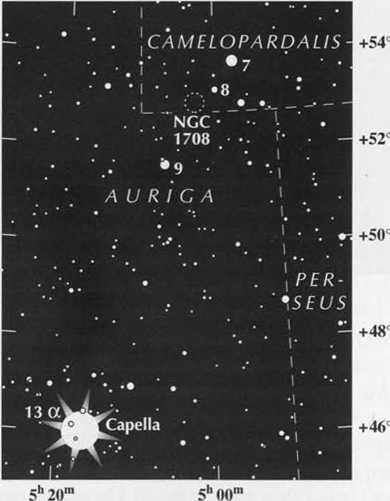
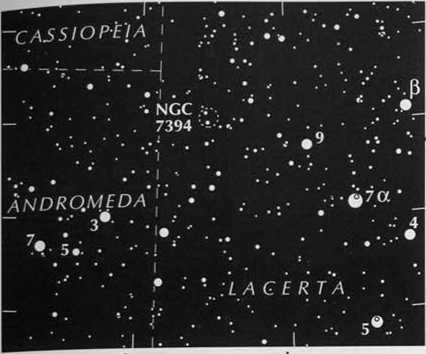
+52'
+50'
+48°
23h00m
22h 40m
Figure 1.9
Finder chart for open cluster NGC 7394.
gated north-south, and 20 x 15 minutes of arc in size. It contains about 10 stars of magnitudes 10 and 11, with a score of fainter ones.”
John Herschel, who discovered NGC 1708 in the year 1831, noted it as “very loose; pretty rich; fills field; the largest star 10th-mag.; mixed magnitudes.” The writer was unable to locate NGC 1708 with his 4-inch refractor on a poor night in Connecticut.
NGC 7394 is in Lacerta (Figure 1.9). The writer’s impression agrees with the Brennan description: “A coarse grouping, 10' by 3' in extent, elongated northwest to southeast. In addition to the bright star at its southeast end, there are about 10 fainter ones. Since the field is not particularly rich, the cluster can be easily recognized.”
When John Herschel swept up this grouping in 1829, he noted in his record book that the measured position referred to “a double star, the last of a poor cluster of about a dozen stars.”
“Coarsely scattered clusters of stars" was William Herschel’s definition of Class VIII, to which he assigned 88 of the objects he discovered. No fewer than 32 of these have been rejected by the RNGC and, as Mr. Brennan comments, it is unlikely that such a capable deep-sky observer could have made so many erroneous observations. Hence this Canadian amateur is conducting a systematic check of all of William Herschel’s “nonexistent” Class VIII clusters.
Every constellation has its grand masters — celestial objects that have become perennial favorites of amateurs around the world. Perseus is loaded with them. Scotty said in December 1988, "This constellation ... is filled with deep-sky wonders, no matter what your taste may be." Of course, his favorite "jewel" in Perseus was the famous Double Cluster. Known since antiquity as a fuzzy star
in the Milky Way, this cluster pair has long fueled the curiosity of skywatchers. Today we can enjoy its twin multitudes of dazzling suns through our backyard telescopes. It is, as C. E. Barns wrote in 1927 in his 1001 Celestial Wonders, "a field shot with diamond dust." Interested in astronomical history, Scotty spent much time viewing the Double Cluster with a replica of Galileo's 20x refractor. "Although I cannot fit both clusters into the same small field of this instrument," he wrote in November 1990, "I wanted to see them just as Galileo first did. It's too bad the Italian astronomer did not have a poet for company that night, for if he did, I'm sure literature would have been richer for it."
The Double Cluster, NGC 869 and 884 (Figure 1.10), also known as h and Chi (%) Persei, is a jewel. To the naked eye it shines with a steady glow, while telescopically its majesty is so compelling that it causes many observers to neglect fainter offerings in the area. These rich conglomerations of stars were known to Hipparchus in the second century B.C. But we can wonder how many Mongol shepherd youths before him knew about these fuzzy twin lights in the winter sky. It was about as faint a nonstellar object as Ptolemy mentioned. Although it is conspicuous to modern stargazers, we find it but briefly mentioned in the Alfonsine Tables 6 and some other old works. Messier did not put the Double Cluster in his catalog. It is sometimes suggested that he felt it was too well known to need mention, but he did list the even more famous Pleiades and
Figure 1.10
To find the beautiful Double Cluster in Perseus, first locate the W in Cassiopeia. Starting at Gamma (y) Cas, hop to Delta (8) and then twice that distance again in the same direction. North is to the right.

Pracsepc as M45 and M44, respectively. Perhaps he felt that there was no chance of its being mistaken for a comet.
To behold its beauty (Figure 1.11), first locate the famous W of Cassiopeia and the constellation Perseus. (Novices who cannot easily identify these star groups are not ready to hunt deep-sky objects.) The easternmost of the W's five stars is Epsilon (e) Cassiopeiae. Northeast of a pont midway between Delta and Epsilon Cassiopeiae is the Double Cluster.
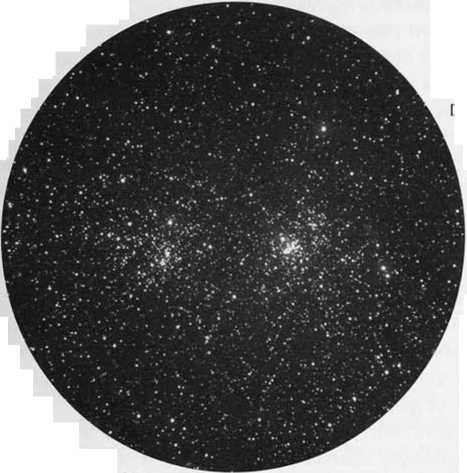
Figure 1.11
The Perseus
Double Cluster is visible to the naked eye under darksky conditions and makes a beautiful sight through any small
telescope.
It should appear as a 4th-magnitude blur to the naked eye. The brightness of an open cluster is often determined by adding the magnitudes of its individual stars. Since the outer limit of a cluster is not always well defined, as more stars are included in the tally, the reported brightness increases. I have seen magnitudes of 3.5 and 3.6 quoted for
NGC 869 and 884, respectively. On the other hand, Brian Skiff of Flagstaff, Arizona, considered just the stars in the cluster’s cores and obtained visual magnitudes of 5.3 and 6.1 for the pair.
Setting the telescope on them is no problem, for all you need do is sight along the tube to get the cluster in the finder. But the following operations give a good idea of how to work in less favorable skies or to locate more difficult objects. Get 2nd-magnitude Alpha (a) Persei in the finder. Then move the telescope north and west until the triangle formed by Gamma (y),Tau (x), and Eta (>1) is in the finder field. Gamma, brightest of the three, and Tau are at the southern corners. Move slightly farther in the same direction until Eta lies just south of the center of the field. Then swing the telescope westward until the jumbled stars of the cluster come into view. If you get lost when moving from one star to another, start over again at the beginning. Try to form the bright signpost stars into simple geometrical patterns. Even after years of practice mistakes occur. If you cannot find it, it’s time to join your local light-pollution committee.
Under a dark sky, a simple opera glass, the optical standby of a century ago, will reveal the two star clusters. Perhaps the most widely read observing guide around the turn of the century was Serviss’s As/ronomy with an Opera-Glass, published in 1888. This book was far more popular than William Tyler Olcott’s Field Book of the Stars, which was published nearly 20 years later. Serviss wrote of the Double Cluster, “With a telescope of medium power, it is one of the most marvelously beautiful objects in the sky — a double swarm of stars, bright enough to be clearly distinguished from one another, and yet so numerous as to dazzle the eye with their lively beams.”
The well-known 19th-century observers W. H. Smyth and Thomas W. Webb both commented on the Double Cluster in their own observing handbooks. Smyth noted that the clusters were quite distinct and that their outer stars were intermingled. He called the pair “one of the most brilliant telescopic objects in the Heavens,” and Webb agreed.
While reading these early authors, I discovered that nowhere in the old descriptions is the pair referred to as the Double Cluster (though Serviss called it a double swarm). I had always assumed that the name was old simply because it is so natural. The first mention of it 1 found, however, is in Kelvin McKready’s A Beginner's Star-Book, published in 1923. But when I asked if anyone knew the source of the name “Double Cluster,” letters arrived from four continents. Smyth did not use the term in his classic Bedford Catalogue (the second volume of his Cycle of Celestial Objects') published in the mid-1800s. By the end of the century it was used as an uncapitalized descriptive term, not as a proper name.
J. P. Liddell of East Woodburn, England, wrote to me saying that the American astronomer Simon Newcomb noted “it may be considered as a double cluster” in his 1901 book The Stars. Liddell adds, “The fact that Newcomb does not call it the Double Cluster indicates that the term was not in general use at the turn of the century.” But the earliest mention discovered to date was found by Sky & Telescope's Dennis di Cicco in George F. Chamber’s 1867 edition of Descriptive Astronomy, which calls the group “the magnificent double cluster in the sword-handle of Perseus.” He also found the term in several popular observing guides published during the 1890s by authors on both sides of the Atlantic.
As early as the 1930s astronomers had some doubt as to the clusters being neighbors in space. Sky Catalogue 2000.0 lists NGC 869 (the western member of the pair) at a distance of 7.200 light-years, while NGC 884 is 7,500. But the uncertainties in making such measurements could easily put 2,000 more light-years between them. With an estimated age of 5.6 million years, NGC 869 is nearly 2'h million years older than NGC 884. Both, however, are very young, having formed shortly before humans first appeared on Earth.
But let’s forget the astrophysics and simply enjoy the spectacle. In the telescope this tremendous blaze of scintillating suns makes a commanding entrance into the eyepiece field. One can look for a long time at the many doubles, the colors, the winding patterns, as the dense cores of the cluster thin out slowly to mer^e finally in the star-rich background of the galaxy itself. Gazing at these clusters produces a succession of feelings too subtle and too complex to be captured by words alone.
Each of these two open clusters would stand well on its own, but they are even more spectacular because, less than a degree apart, they are visible in the same low-power field. I see h Persei (NGC 869) being the slightly brighter and more concentrated of the two. Betjvar’s Atlas Catalogue* gives the star count in NGC 869 as 250. Just 'h° east, % Persei is said to contain some 300 stars. However, anyone who looks at these clusters with a 10-inch telescope will certainly consider the catalog values to be conservative.
While Robert Burnham, Jr., in his Celestial Handbook, suggests that the pair is best seen with a rich-field telescope, I prefer the view in a long-focus instrument that produces a darker background and more contrast. My most spectacular view of the Double Cluster came in a 6-inch refractor equipped with a unique wide-field eyepiece of 4-inch focal length made by Art Leonard.
You can also use the Double Cluster to gauge your nightly sky conditions. Begin with a photograph of the group and select an easily identified field near the edge of one cluster. Draw a map of the area with a fairly large scale of, say, 1° to 8 inches.
Plot the star brightnesses as carefully as possible. Compare the chart to an actual low-power eyepiece field and make whatever brightness corrections are needed. Next, choose a small area on the chart and include all the faint stars visible in the low-power field. Then, switching to a higher magnification, add in the faintest stars your telescope will show.This chart can be compared with the view on other nights. Although you will not have an actual value for the magnitude limit of your telescope, you will be able to tell which nights are better than others by checking the chart against the telescopic view. It would be best always to use the same eyepiece when making this test.
By the way, while in the area, be sure to search for the dark nebula Barnard 201, about a degree due west of h Persei. Try sweeping the area around the Double Cluster; there are several other dark nebulae nearby. The 12-inch f/17 Porter turret telescope at Stellafane showed several of them quite well.
Sometimes the obvious escapes us. For instance, many Southern Hemisphere celestial wonders are visible from mid-northern latitudes. A few decades ago, most Northern Hemisphere amateurs would have considered seeking them out a worthless pursuit. But Scotty knew better. In his column he continually proclaimed
Fte catalog is the companion to Be<;var's Atlas of the Heavens. the possibilities of "going south." He loved the temptation to tip his telescope to extreme southern declinations and scout out the "unachievable." The Fornax Group of galaxies is a good example of the treasures he knew existed down south. In January 1957 he wrote: "Most people do not realize that this amazing group is within the reach of an observer in latitude 40° north, if he has a fine, clear sky near the southern horizon. It is worth watching for a perfect night so that this tightly clustered group may be viewed at its best on the meridian, early these January evenings. Were this array in northern declinations, it would be one of the great shows of the sky." With these words, Scotty opened the door to this southern "hot" zone of galaxies and other celestial wonders for Northern Hemisphere observers.
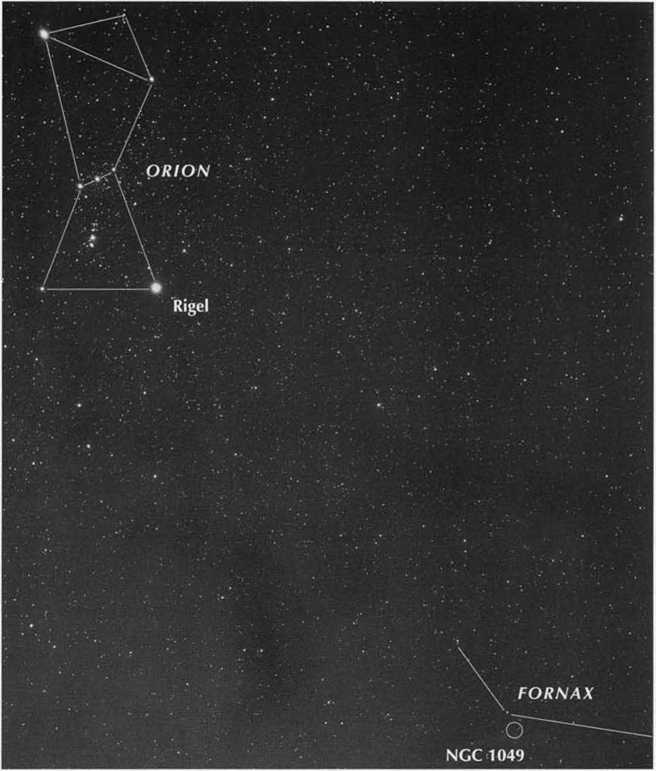
Figure 1.12
Although low on the southern horizon from mid-northern latitudes, the constellation Fornax rewards deep-sky observers hunting for galaxies. Look for it some 25° southwest of bright Rigel in Orion.
January evenings are perfect for exploring the dim expanse of the constellation
Fornax, the Furnace (Figure 1.12). While many see Fornax as vacant space, it contains some remarkable deep-sky objects. Its lucida* is only 4th magnitude, however, so when working this area it helps to have a finder of 2-inch aperture or larger on your telescope. Hunting objects in this part of the sky is easier than some may think. Although bright stars are rather sparse, even the smallest telescope finder will show an ample selection near many of the objects of interest.
If the Stinger stars in the tail of Scorpius clear your southern horizon during the summer, then you have access to all of Fornax during the winter. A good place to begin is Alpha (a) Fornacis, a neat.4th-magnitude double star. The 7th-magnitude companion, which is suspected of being variable, takes about 300 years to complete an orbit. Of course, readers who have enjoyed Harlow Shapley’s Galaxies will recall his account of the Fornax Group (Figure 1.13), and those who have looked up the region in the Skalnate Pleso Atlas find a dense swarm of spirals. But even so. a clear sky will show so many galaxies fainter than the 13th-magnitudc limit that identifications are almost impossible, and amateurs must satisfy themselves with the spectacle of unnamed wonders. Half a
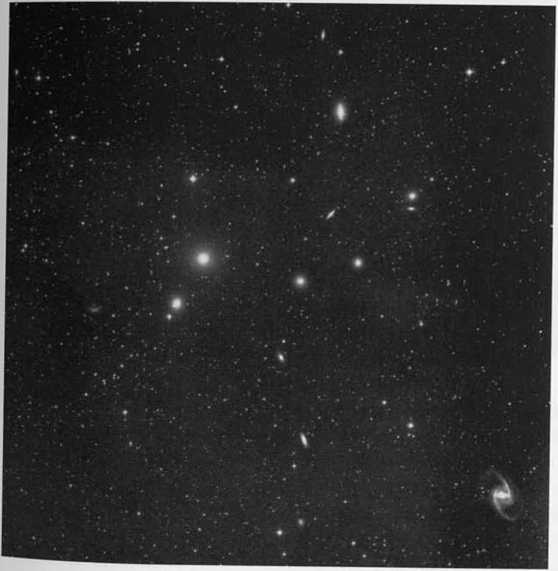
Figure 1.13
Galaxies in Fornax show a wide variety of shapes — from ellipticals to spirals. Some appear edge on. The barred spiral in the lower right corner is NGC 1365.
4 term for the brightest star in a constellation.
dozen of these galaxies are brighter than magnitude 11.5 and hence visible in small telescopes; they are comparable with the fainter Messier objects. The brightest is lOth-magnitude NGC 1316, easy in a 3-inch. John Herschel described it in 1837 as “very bright, very large, 4' in diameter, brightening first gradually and then suddenly toward the middle to a starlike nucleus.” His description still holds for my 10-inch reflector in Kansas.
Just north of NGC 1316 lies 12th-magnitude NGC 1317. A large telescope and a fine night will bring out faint NGC 1318 between the two; a 10-inch shows the
Figure 1.14
Globular cluster NGC 1049 in Fornax.
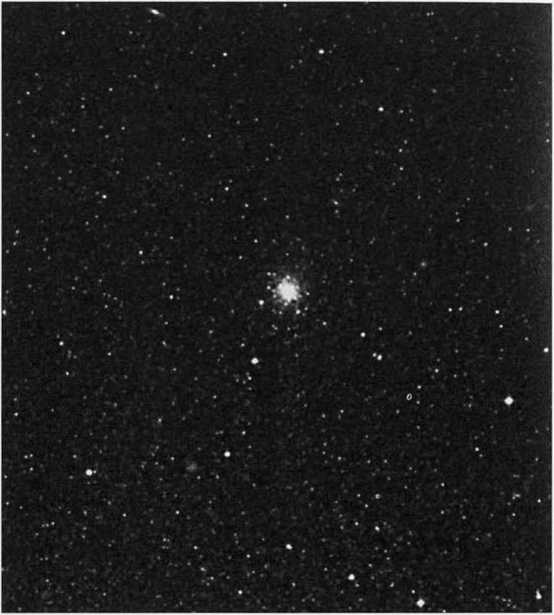
last with difficulty. But the highlight of the Fornax array is NGC 1365, a large llth-magnitude barred spiral fully 8' long, which can be observed even with a 3-inch. With its obviously lenticular form and bright central part, it reminds one of binocular views of the Andromeda Galaxy, M31.
There are too many galaxies in Fornax to detail them all. But one last one I’ll mention stands out because of its astronomical interest. Simply called the Fornax System, it is the largest of a relatively rare class of galaxies known as dwarf spheroidals — the smallest and intrinsically faintest galaxies yet to be observed. We see this object only because it is close at hand. Estimates place it 600,000 light-years from the Milky Way — more than three times farther than the Magellanic Clouds, but only a quarter the distance of M31.1 know of no visual observations of the Fornax System, but other seemingly impossible observing challenges have been conquered by amateurs in recent years.
Some astronomers liken dwarf spheroidals to overgrown globular clusters. Thus it is somewhat ironic that several true globulars have been found associated with the Fornax System. NGC 1049 (Figure 1.14) is one such globular. It was bright enough to be picked up by John Herschel and is within reach of modern amateur telescopes. It will be a test of the observer’s skill, however, as its 13th-magnitude disk is only '// across.
A Fantastic Fornax Planetary
Down in Potter Valley, California. Todd Hansen avidly tracks every planetary nebula within reach at his 39° latitude. He is quite capable of identifying a 1" planetary nebula that looks for all the world like a star at first glance. So when he ran across NGC 1360 in Fred Klein’s selected list of 500 observing objects, he promptly turned his telescope to Fornax. There, to his surprise, he found not the tiny planetary he expected, but a “significant object not in the Atlas of the Heavens." In his notebook he wrote: “Medium brightness, large, oval, unconcentrated. Quite a glowing cloud, must be 7th- or Sth magnitude overall, and a noteworthy object.’’ But why hadn’t he run across it before?
The history of this object is strange. It was found in 1857 by Lewis Swift and later by August Winnecke, both well-known comet hunters of the time. How John Herschel missed it in his sweeps, or why observer James Dunlop overlooked it in his catalog, is most curious.
The planetary was known to a few, however, because amateur astronomer Ernst J. Hartung comments on it in his Astronomical Objects for Southern Telescopes. Hartung’s description is close to Hansen’s. A short notice on this object was included in Deep-Sky Wonders for December 1972, and it surprises me now. I wrote that NGC 1360 was not seen with a 4-inch refractor but glimpsed with a fast 5-inch refractor — a sad testimony to the murk of my Connecticut skies that evening. In 1985, from Joshua Tree National Monument in the California desert, I saw it clean and bright with a little Tuthill Star Trap on a tiny Dobsonian mounting. The sky that night had a naked-eye magnitude limit of 7.5. Hansen’s description seems to be accurate.
Again, do not let the Fornax label put you off from searching for it. Perhaps NGC 1360 is overlooked because it is in a nondescript constellation that U. S. observers subconsciously class as “too far south.” The planetary, however, is no farther south than the globular cluster M4 near Antares, which even beginning observers quickly hunt down in the summertime sky. It should be visible easily from deep into the Canadian provinces. In their Revue des constellations, R. Sagot and J.Texereau state that NGC 1360 has been seen in a 2.2-inch refractor.
University of Illinois astronomer James B. Kaier points out several interesting facts concerning NGC 1360. The nebula is one of the few known examples of a large, high-excitation planetary. Its llth-magnitude central star has a surface temperature of at least 85,000° Kelvin. It is some 14 times hotter than the Sun and at least 540 times more luminous, but has only about one-tenth the Sun's diameter. The nebula, with an estimated diameter of 2 light-years, is perhaps twice the size of the Ring Nebula in Lyra, and about half the size of the largest planetaries known.
After I asked for notes from people who had seen NGC 1360, over three dozen letters arrived from observers who were delighted with the view. This object should be added to every winter star party observing list.
JANUARY OBJECTS
|
Nome |
Type |
Const. |
R.A. h m |
Dec. o / |
Millennium Star Atlas |
Uranometria 2000.0 |
Sky Atlas 2000.0 |
|
Alpha (a) Foma® |
♦ |
For |
03 12.0 |
-29 00 |
380 |
311,355 |
18 |
|
Andromeda Goloxy, M31, NGC 224 |
Gx |
And |
00 42.7 |
+41 16 |
104,105 |
60 |
4,9 |
|
8201 |
DN |
Per |
02 13.0 |
+57 05 |
— |
— |
— |
|
Bornord's Loop, Sh2-276 |
BN |
Ori |
05 56.0 |
-02 00 |
252,254, 229, 230, 276,277 |
226 |
11, B2 |
|
Double Cluster (east), NGC 884 |
OC |
Per |
02 22.4 |
+57 07 |
46,62 |
37 |
1 |
|
Double Cluster (west), NGC 869 |
OC |
Per |
02 19.0 |
+57 09 |
46,47,62 |
37 |
1 |
|
Fornox System, ESO 356-4 |
Gx |
For |
02 39.0 |
-34 30 |
403 |
354 |
18 |
|
Horsehead Nebula, 833 |
DN |
Ori |
05 41.0 |
-02 24 |
253,277 |
225, 226 |
11, B2 |
|
Hubble's Variable Nebula, NGC 2261 |
BN |
Mon |
06 39.2 |
+08 44 |
202, 203, 226, 227 |
182,183 |
11,12 |
|
IC434 |
BN |
Ori |
05 41.0 |
-02 24 |
253, 254, 277, 278 |
225, 226 |
11,82 |
|
M33, NGC 598 |
Gx |
Tri |
01 33.9 |
+30 39 |
146 |
91 |
4 |
|
NGC 604 |
BN |
Tri |
01 34.4 |
+30 47 |
146 |
91 |
— |
|
NGC1049 |
GC |
For |
02 39.7 |
-34 17 |
403 |
354 |
18 |
|
NGC 1316 |
Gx |
For |
03 22.7 |
-37 12 |
401 |
355 |
18 |
|
NGC1317 |
Gx |
For |
03 22.8 |
-37 06 |
401 |
355 |
18 |
|
NGC1318 |
Gx |
For |
03 22.8 |
-37 07 |
— |
_ |
— |
|
NGC1360 |
PN |
For |
03 33.3 |
-25 51 |
356 |
312 |
— |
|
NGC1365 |
Gx |
For |
03 33.6 |
-36 08 |
401 |
355 |
18 |
|
NGC 1662 |
OC |
Ori |
04 48.5 |
+10 56 |
208 |
179 |
11 |
|
NGC 1708 |
OC BN |
Com |
05 02.6 |
+52 53 |
i— |
— |
— |
|
NGC2024 |
Ori |
05 41.9 |
-01 51 |
253 |
225, 226 |
11, B2 | |
|
NGC2063 |
OC |
Ori |
05 46.8 |
+08 48 |
_ |
_ |
_ |
|
NGC2169 |
OC |
Ori |
06 08.4 |
+13 57 |
204 |
181,182 |
11,12 |
|
NGC 2180 |
OC |
Ori |
06 09.6 |
+04 43 |
_ |
_ |
_ |
|
NGC2184 |
OC |
Ori |
06 10.9 |
-03 31 |
— |
— |
— |
|
NGC2251 |
OC |
Mon |
06 34.7 |
+08 22 |
203,227 |
182 |
11,12 |
= Asterism; BN = Bright Nebula; CGx = Ouster of Galaxies; DN = Dork Nebulo; GC = Globular Cluster; Gx = Goloxy; ~ Open Cluster; PN = Planetary Nebulo; * = Star; ** = Double/Multiple Star; Vor = Variable Star
JANUARY OBJECTS (CONTINUED)
|
Nome |
Type |
Const. |
R.A. h m |
Dec. O / |
Millennium Star Atlos |
Uranomelria 2000.0 |
EE® |
|
NGC 7394 |
OC |
Lac |
22 50.6 |
+52 10 |
1085 — |
— | |
|
Orion Nebula, M42, NGC 1976 |
BN |
Ori |
05 35.4 |
-05 27 |
278 |
225, 226, 270, 271 |
11, B2 |
|
Pleiades, M45 |
OC |
Tou |
03 47.0 |
+24 07 |
163 |
132 |
4, A2 |
|
T Orionis |
Var |
Ori |
05 35.8 |
-05 29 |
278 |
225, 226, 270, 271 |
— |
|
Trapezium, Theta (0) Orionis |
** |
Ori |
05 35.3 |
-05 23 |
278 |
225,226, 270,271 |
11, B2 |
|
Asl = Asterism; BN = Bright Nebula; CGx = Cluster of Galoxies; DN = Dork Nebula; GC = Globular Cluster; Gx = G OC = Open Cluster; PN = Planetary Nebula; * = Star; *» = Double/Mulliple Star; Var = Variable Star |
ialaxy; | ||||||
